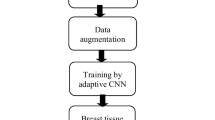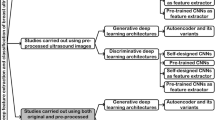Abstract
An accurate diagnosis of breast cancer requires analyzing the tumors and giving appropriate treatment. A cancer diagnosis should be carried out as early as possible to minimize mortality rates. The handcrafted features are utilized for traditional breast cancer diagnosis, and the system’s performance is based on selected features. However, it is a challenging task to analyze shape complexity and different sizes. In recent years, deep learning has become a viable alternative to overcome the drawbacks of conventional cancer diagnosis methods. In this work, machine learning (ML) classifier, deep convolutional neural network (CNN) and transfer learning models (Alexnet, VGG-16, VGG-19, Resnet-50, and Resnet-101) are used to analyse the performance of the classifier. To process data before machine learning classification, an anisotropic diffusion filter is used to extract the tumor. The significant ten features were selected based on statistical testing and achieved an accuracy of 99% in the KNN classifier. The proposed deep CNN achieves a most satisfactory accuracy of 100%. The results outperform current techniques and demonstrate the ability of breast cancer classification. Also, the fast evaluation speed makes the analysis possible in real-time. The accuracy results of Alexnet, VGG-16, VGG-19, Resnet-50, and Resnet-101 are 86%, 82%, 84%, 84% and 74% respectively. Due to the small size of the data, the transfer learning model produces insignificant results, whereas the transfer learning models require a specific data size. The CNN can classify breast ultrasound images of cancer with promising results with relatively few training cases and is suitable for biomedical applications.
















Similar content being viewed by others
References
Agarwal V, Abidi BR, Koschan A, Mongi A, Abidi (2006) An overview of color constancy algorithms. J Pattern Recognit Res 1(1):42–54
Akin O, Sandra B, Brennan DD, Dershaw MS, Ginsberg MJ, Gollub H, Schöder DM, Panicek, Hricak H (2012) Advances in oncologic imaging: update on 5 common cancers. Cancer J Clin 62(6):364–393
Ara SR, Alam F, Rahman MH, Akhter S, Awwal R, Hasan MK (2015) Bimodal multiparameter-based approach for benign–malignant classification of breast tumors. Ultrasound Med Biol 41(7):2022–2038
Azar AT, El-Metwally SM (2013) Decision tree classifiers for automated medical diagnosis. Neural Comput Appl 23:2387–2403
Bansal M, Kumar M, Sachdeva M, Mittal A (2021) Transfer learning for image classification using VGG19: Caltech-101 image data set. J Ambient Intell Humaniz Comput:1–12. https://doi.org/10.1007/s12652-021-03488-z
Barbu T (2021) Automatic edge detection solution using anisotropic diffusion-based multi-scale image analysis and fine-to-coarse tracking. Proc Rom Acad - Math Phys Tech Sci Inf Sci 22(3):267–274
Becker AS, Mueller M, Stoffel E, Marcon M, Ghafoor S, Boss A (2018) Classification of breast cancer in ultrasound imaging using a generic deep learning analysis software: a pilot study. Br J Radiol 91:20170576
Bedi AK, Sunkaria RK, Mittal D (2017) Enhancement of ultrasound images using modified anisotropic diffusion model in non-subsampled shearlet domain. 2017 International Conference on Computing, Communication and Automation (ICCCA), 1119–1124
Bishop CM (2006) Pattern recognition. Mach Learnning l4(4):738
Byra M (2018) Discriminant analysis of neural style representations for breast lesion classification in ultrasound. Biocybernet Biomed Eng 38(3):684–690
Byra M, Nowicki A, Wróblewska-Piotrzkowska H, Dobruch-Sobczak K (2016) Classification of breast lesions using segmented quantitative ultrasound maps of homodyned K distribution parameters. Med Phys 43(10):5561–5569
Byra M, Galperin M, Ojeda Fournier H, Olson L, O’Boyle M, Comstock C, Andre M (2019) Breast mass classification in sonography with transfer learning using a deep convolutional neural network and color conversion. Med Phys 46(2):746–755
Cheng H, Shan J, Ju W, Guo Y, Zhang L (2021) Automated breast cancer detection and classification using ultrasound images: A survey. Pattern Recognit 43(1):299–317
Chhabra P, Garg NK, Kumar M (2020)Content-based image retrieval system using ORB and SIFT features. Neural Comput Appl 32(7):2725–2733
Chiang TC, Huang YS, Chen RT, Huang CS, Chang RF (2018) Tumor detection in automated breast ultrasound using 3-D CNN and prioritized candidate aggregation. IEEE Trans Med Imaging 38(1):240–249
Choi JS, Han BK, Ko ES, Bae JM, Ko EY, Song SH, Kwon MR, Shin JH, Hahn SY (2019) Effect of a deep learning framework-based computer-aided diagnosis system on the diagnostic performance of radiologists in differentiating between malignant and benign masses on breast ultrasonography. Korean J Radiol 20(5):749–758
Ciritsis A, Rossi C, Eberhard M, Marcon M, Becker AS, Boss A (2019) Automatic classification of ultrasound breast lesions using a deep convolutional neural network mimicking human decision-making. Eur Radiol 29(10):5458–5468
Dalal N, Triggs B (2005) Histograms of oriented gradients for human detection. In: 2005 IEEE computer society conference on computer vision and pattern recognition (CVPR’05), 886–893
Garg D, Garg NK, Kumar M (2018) Underwater image enhancement using blending of CLAHE and percentile methodologies. Multimed Tools Appl 77(20):26545–26561
Geras KJ, Wolfson S, Shen Y, Wu N, Kim SG, Kim E, Heacock L, Parikh U, Moy L, Cho K (2017)High-resolution breast cancer screening with multiview deep convolutional neural networks. In: Proceedings, Conference on Computer Vision and Pattern Recognition. arXiv preprint arXiv:1703.07047
Girshick R, Donahue J, Darrell T, Malik J (2014) Rich feature hierarchies for accurate object detection and semantic segmentation. In: Proceedings of the IEEE conference on computer vision and pattern recognition, 580–587
Gokhale S (2009) Ultrasound characterization of breast masses. Indian J Radiol Imaging 19(3):242
Guan F, Ton P, Ge S, Zhao L (2014) Anisotropic diffusion filtering for ultrasound speckle reduction. Sci China Technol Sci 57:607–614
Gupta K (2020) Analysis of histopathological images for prediction of breast cancer using traditional classifiers with pre-trained CNN. Procedia Comput Sci 167:878–889. https://doi.org/10.1016/j.procs.2020.03.427
Han S, Kang HK, Jeong JY, Park MH, Kim W, Bang WC, Seong YK (2017) A deep learning framework for supporting the classification of breast lesions in ultrasound images. Phys Med Biol 62(19):7714
He K, Zhang X, Ren S, Sun J (2015) Spatial pyramid pooling in deep convolutional networks for visual recognition. IEEE Trans Pattern Anal Mach Intell 37(9):1904–1916
He K, Zhang XY, Ren SQ, Sun J (2016) Deep residual learning for image recognition. In: 2016 IEEE Conference on Computer Vision and Pattern Recognition (CVPR), 770–8
Hijab A, Rushdi MA, Gomaa MM, Eldeib A (2019) Breast cancer classification in ultrasound images using transfer learning. In 2019 Fifth International Conference on Advances in Biomedical Engineering (ICABME). 1–4
Howlader N, Noone AM, Krapcho M, Miller D, Bishop K, Kosary CL, Yu M, Ruhl J, Tatalovich Z, Mariotto A, Lewis DR, Chen HS, Feuer EJ, Cronin KA (eds) (2017) SEER Cancer Statistics Review, 1975–2014
Iakovidis DK, Keramidas EG, Maroulis D (2008) Fuzzy local binary patterns for ultrasound texture characterization. In: International conference image analysis and recognition, 750–759
Krizhevsky A, Sutskever L, Hinton GE (2012) Imagenet classification with deep convolutional neural networks. Neural Inf Process Syst 60:1097–1105
Kumar M, Chhabra P, Garg NK (2018) An efficient content based image retrieval system using BayesNet and K-NN. Multimed Tools Appl 77(16):21557–21570
Kumar M, Jindal MK, Sharma RK, Jindal SR (2020) Performance evaluation of classifiers for the recognition of offline handwritten Gurmukhi characters and numerals: a study. Artif Intell Rev 53(3):2075–2097
Liaw A, Wiener M (2002) Classification and regression by random Forest. R News 2(December):18–22
Marc K, Luciano MP, Ross WF, Geis JR (2017) Implementing machine learning in radiology practice and research. Am J Roentgenol 208(4):754–760
Moon WK, Chen IL, Chang JM, Shin SU, Lo CM, Chang RF (2017) The adaptive computer-aided diagnosis system based on tumor sizes for the classification of breast tumors detected at screening ultrasound. Ultrasonics 76:70–77
Moura DC, López MAG (2013) An evaluation of image descriptors combined with clinical data for breast cancer diagnosis. Int J Comput Assist Radiol Surg 8(4):561–574
Narayanan SK, Wahidabanu RSD (2009) A view on despeckling in ultrasound imaging. Int J Signal Process 2(3):85–98
Ong M-S, Kenneth D, Mandl (2015) National expenditure for false-positive mammograms and breast cancer overdiagnosis estimated at $4 billion a year. Health Aff 34(4):576–583
Pan SJ, Yang Q. A survey on transfer learning. IEEE Trans Knowl Data Eng 22:1345–1359
Rajaguru H, Prabhakar SK (2017) Bayesian linear discriminant analysis for breast cancer classification. In: 2017 2nd International Conference on Communication and Electronics Systems (ICCES), 266–269
Ren H, Li ZN (2015) Object detection using generalization and efficiency balanced co-occurrence features. In: Proceedings of the IEEE International Conference on Computer Vision, 46–54
Rodrigues PS (2017) Breast ultrasound image. Mendeley Data 1. https://doi.org/10.17632/wmy84gzngw.1
Russakovsky O, Deng J, Su H, Krause J, Satheesh S, Ma S, Huang Z, Karpathy A, Khosla A, Bernstein M, Berg AC (2015) Imagenet large scale visual recognition challenge. Int J Comput Vision 115(3):211–252
Sadeghi-Naini A, Suraweera H, Tran WT, Hadizad F, Bruni G, Rastegar RF, Curpen B, Gregory J, Czarnota (2017)Breast-lesion characterization using textural features of quantitative ultrasound parametric maps. Sci Rep 7(1):1–10
Shaheed K, Mao A, Qureshi I, Kumar M, Hussain S, Ullah I, Zhang X (2022) DS-CNN: A pre-trained Xception model based on depth-wise separable convolutional neural network for finger vein recognition. Expert Syst Appl 191:116288
Simonyan K, Zisserman A (2015) Very deep convolutional networks for large-scale image recognition. In: International Conference on Learning Representations (ICLR). https://arxiv.org/abs/1409.1556
Singh S, Ahuja U, Kumar M, Kumar K, Sachdeva M (2021) Face mask detection using YOLOv3 and faster R-CNN models: COVID-19 environment. Multimed Tools Appl 80(13):19753–19768
Stavros A, Thickman D, Rapp C, Dennis M, Parker S, Sisney G (1995) Solid breast nodules: Use of sonography to distinguish between benign and malignant lesions. Radiology 196(1):123–134
Tan T, Platel B, Huisman H, Sánchez CI, Mus R, Karssemeijer N (2012)Computer-aided lesion diagnosis in automated 3-D breast ultrasound using coronal spiculation. IEEE Trans Med Imaging 31(5):1034–1042
Torheim T, Malinen E, Kvaal K, Lyng H, Indahl UG, Andersen EKF, Futsaether CM (2014) Classification of dynamic contrast-enhanced MR images of cervical cancers using texture analysis and support vector machines. IEEE Trans Med Imaging 33(8):1648–1656
Xi J, Ye L, Huang Q, Li X (2021) Tolerating data missing in breast cancer diagnosis from clinical ultrasound reports via knowledge graph inference. In: Proceedings of the 27th ACM SIGKDD Conference on Knowledge Discovery & Data Mining, 3756–3764
Yamashita R, Nishio M, Do RK, Togashi K (2018) Convolutional neural networks: an overview and application in radiology. Insights Imaging 9(4):611–629
Yap MH, Edirisinghe E, Bez H (2010) Processed images in human perception: A case study in ultrasound breast imaging. Eur J Radiol 73(3):682–687
Yap MH, Pons G, Martí J, Ganau S, Sentís M, Zwiggelaar R, Davison AK, Marti R (2017) Automated breast ultrasound lesions detection using convolutional neural networks. IEEE J Biomed Health Inf 22(4):1218–1226
Zeebaree DQ, Abdulazeez A, Zebari DA, Haron H, Hamed HN (2021)Multi-level fusion in ultrasound for cancer detection based on uniform LBP features. Comput Mater Continua 66(3):3363–3382
Author information
Authors and Affiliations
Corresponding author
Additional information
Publisher’s note
Springer Nature remains neutral with regard to jurisdictional claims in published maps and institutional affiliations.
Rights and permissions
About this article
Cite this article
Karthiga, R., Narasimhan, K. Automated diagnosis of breast cancer from ultrasound images using diverse ML techniques. Multimed Tools Appl 81, 30169–30193 (2022). https://doi.org/10.1007/s11042-022-12933-w
Received:
Revised:
Accepted:
Published:
Issue Date:
DOI: https://doi.org/10.1007/s11042-022-12933-w




